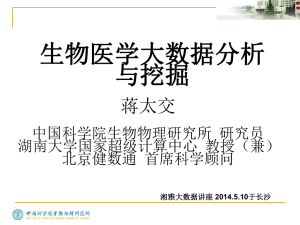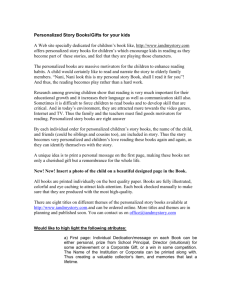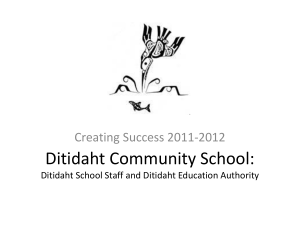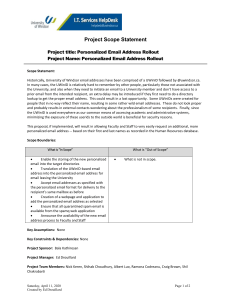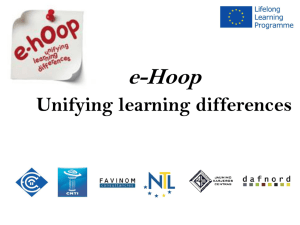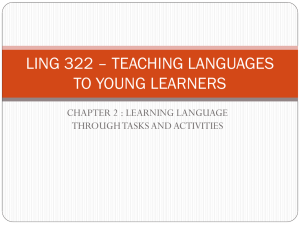slides - Georgetown Digital Commons
advertisement
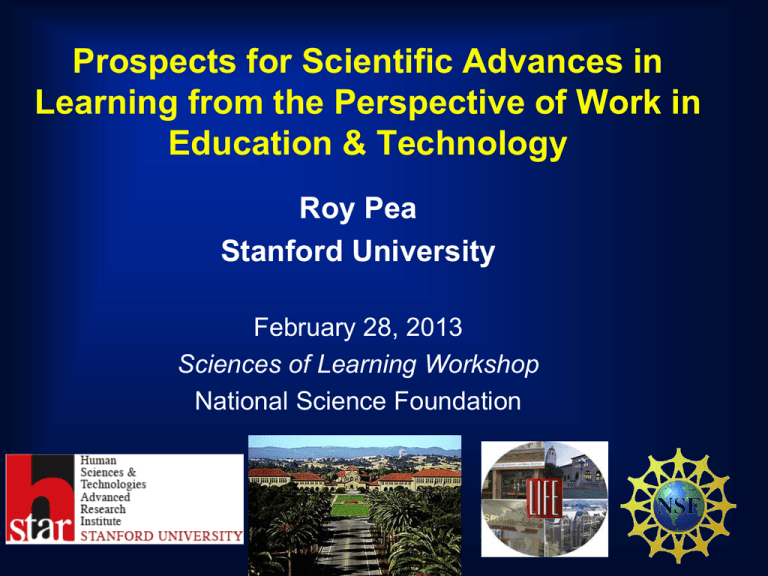
Prospects for Scientific Advances in Learning from the Perspective of Work in Education & Technology Roy Pea Stanford University February 28, 2013 Sciences of Learning Workshop National Science Foundation Educate for Broader Competencies • Preliminary classification of skills, abilities • Importance of Deeper Learning, 21st Century Skills • Perspectives on Deeper Learning • Deeper Learning of ELA, Math, Science • Teaching & assessing for transfer • Systems to support Deeper Learning Three Broad Domains of Competencies • Cognitive • Cognitive processes and strategies • Knowledge • Creativity • • • • Critical thinking Information literacy Reasoning Innovation • • • • Flexibility Initiative Appreciation for diversity Metacognition • • • • Communication Collaboration Responsibility Conflict resolution • Intrapersonal • Intellectual openness • Work ethic and conscientiousness • Positive core self-evaluation • Interpersonal • Teamwork and collaboration • Leadership Why broader competencies? • Important for broadening STEM participation • More than cognitive processes and strategies at stake in educational participation • Interpersonal issues such as stereotype threat, social belonging, difficulties in communication and collaboration • Intrapersonal issues such as ‘academic tenacity’ — motivation, self-beliefs, disciplinary identity, self-regulation • All are consequential for selecting and maintaining STEM learning pathways Hyperconnected World • 125 Mil US consumer smartphones • Up 29% in a year, 99% in two years • 50 Mil US tablets • US 8 to 18 yr olds: 11 hrs media use a day (in 7.5 hrs!) - increasing media multitasking - three screens: TV, computers and mobile phones Next decade of technology-enhanced learning opportunities combines… • Very-low cost “always-on” networked smart mobiles for on-demand learning resources • Elastic cloud computing & “software-as-services” platforms • Increasingly open educational resources, tagged to learning standards and learning maps • More accessible open platforms for developing learning and educational tools for use 24/7 • Participatory media culture • Ubiquitous sensors (GPS+) and location-aware services for learning-in-the world • Increasingly accessible data visualization • Immersive worlds and games – for learning, too • Social networks used for learning and education Grand Challenge Problem #1 • “Design and validate an integrated system that provides real-time access to learning experiences tuned to the levels of difficulty and assistance that optimize learning for all learners, and that incorporates self-improving features that enable it to become increasingly effective through interaction with learners.” • Such integrated systems should: • Discover appropriate learning resources… • Configure those resources with forms of representation and expression appropriate for the learner’s age, prior knowledge, reading ability, and language. • Select appropriate paths and scaffolds for moving the learner through the learning resources with the optimal level of challenge and support. Grand Challenge Problems: History • A grand challenge defines a commitment by a scientific community to work together towards a common goal - valuable and achievable within a predicted timescale. • Predecessor: Hilbert’s 1900 address to International Congress of Mathematicians on 23 major mathematical problems to be studied for the next century. • “Grand Challenges”: major problems of science and society whose solutions require 1000-fold or greater increases in the power and speed of supercomputers and their supporting networks, storage systems, software and virtual environments: • U.S. High Performance Computing and Communications program (HPCC, 1991) Larry Smarr, NCSA Director, c. 1989 Personalized Learning GCP Criteria 1) Understandable, with Significance. Inspiration Clearly stated compelling case for contributing to long term benefits for science, industry and society. 2) Challenging, and Timely. Hard problems within conceivable reach in 15-20 years with concerted coordinated efforts. 3) Clearly useful, in terms of Impact and Scale, if problem is solved. Contributes to long term benefits for many people at large, and with international scope. 4) Metrics: Testable and Incremental. Can measure progress, incremental milestones. Jim Gray: Director, Microsoft Research Lab, San Francisco Jim Gray (2003). What Next? A Dozen InformationTechnology Research Goals. Journal of the ACM, 50(1), 41–57. Learning Analytics is about collecting traces that learners leave behind and using those traces to improve learning. (Eric Duval, U. Leuven, Belgium, LAK 2012) • LA informs personalized, adaptive learning pathways through online learning systems that can better support learning for everyone • Recommended learning resources • More engaging and inspiring 24/7 learning: games, projects, badges for competencies • Can we identify students’ difficulties early and provide the kinds of support needed for success? • Suggests continuously improvable curricula: Learning networks getting smarter with every click Towards Personalized Learning • Vannevar Bush’s Memex • Danny Hillis @ Oscon July 2012 Towards Personalized Learning • Danny Hillis story; Oscon July 2012 Towards Personalized Learning • Danny Hillis story; Oscon July 2012 Towards Personalized Learning • Danny Hillis story; Oscon July 2012 Towards Personalized Learning • Danny Hillis story; Oscon July 2012 Towards Personalized Learning • Danny Hillis story; Oscon July 2012 http://www.lrmi.net/ Towards Personalized Learning Shared Learning Collaborative: http://slcedu.org Active in Learning Analytics: .com., org, .edu Bringing broader competencies into the learning mapping • Needed: studies of intertwined relationships during learning & human development between cognitive, intrapersonal and interpersonal categories of competencies • Needed: studies of learning progressions to inform learning maps for K-12 beyond mathematics • Needed: college-level research on these topics Use Richer Pedagogical Models • • • • • • • • • • Project-based learning Problem-based learning Complex system modeling Cognitive apprenticeships Knowledge building communities Computer games, sims for learning Communities of practice Learning in virtual worlds Immersive and embodied learning Learning by argumentation We need Education Data Scientists to Make Progress on Many Issues • Modeling challenges: User Knowledge, User Behavior & User Experience modeling, User Profiling; Domain modeling; Learning component analysis; Social learning capital • Challenges in adaptation, personalization, recommendations, group learning • Interactive data visualization systems for “runtime” guidance for learners, teachers, leaders: enabling learners to see directly how their effort improves their success. Challenge #2: Multi-modal learning science and technology development • Need: to capture, integrate and make systematic inquiries into large-scale, multimodal data streams of socially and contextually-situated learning & teaching interactions in-situ… • Learners and teacher in a classroom • Collaborators in a project-based learning environment after-school • Learning on the move with mobile devices • Out-of-MOOC interactions among peers face to face or using other social media platforms • Onsite workplace learning outside classes Why? Missing vital data • Human learning is a complex multi-sensory affair of embodied semiotic interactions • The production and perception of meaning in context engages the full range of sensory modalities for learning; and context is continually being re-created • Increasing challenges associated for inquiry into how learning is occurring within and across formal and informal settings, as learners and educational systems exploit increasingly pervasive mobile learning devices and online educational applications and resources such as MOOCs, OER, Wikipedia, web search, and digital curricula, games and simulations ‘Sensorium’: Quantified Self for Learning • • “Sensing” of learning contexts and recognition of the people, gestures, discourse patterns, activities, and bio-behavioral responses in them will be an important complement to “learning analytics” and “educational data-mining”, enabling new kinds of predictions and learning-relevant resources and supports. Can exploit ‘lifelogging’ technologies: memory augmentation, medical diagnostics, behavior change; data privacy challenges Multimodal Learning Sciences: Sense-making technologies • Needed: technologies and associated methodologies for integrating diverse data types from sensor streams and human-coded data, and multimodal data stream ‘workbenches’, incorporating analytic tools for sense-making and pattern detection with rich interactive data visualization capabilities for examining data stream inter-relationships • Audio, video, bio-sensors, GPS, digital pen inputs, clickstreams… Grow Interdisciplinary Collaboratories • Inter-disciplinary collaboratories: • Social sciences, computer sciences, electrical engineering, statistics, learning sciences, neurosciences, educational research, disciplinary domain expertise • Better coordination across PIs, Labs, Industry • Greater cumulativity of approaches, theories, findings, tools & platforms, open data Prospects for Scientific Advances in Learning from the Perspective of Work in Education & Technology Roy Pea Stanford University February 28, 2013 Sciences of Learning Workshop National Science Foundation
